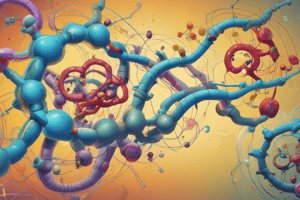Podcast
Questions and Answers
What is the primary function of the active site on an enzyme?
What is the primary function of the active site on an enzyme?
- To change the shape of the enzyme
- To increase the activation energy
- To bind to the substrate (correct)
- To catalyze the chemical reaction
What determines the substrate specificity of an enzyme?
What determines the substrate specificity of an enzyme?
- The shape and chemical properties of the active site (correct)
- The temperature of the reaction
- The size of the enzyme
- The pH of the reaction
What is the result of an enzyme catalyzing a chemical reaction?
What is the result of an enzyme catalyzing a chemical reaction?
- The rate of the reaction is increased (correct)
- The equilibrium of the reaction is altered
- The substrate is converted to an inhibitor
- The enzyme is degraded
What is the purpose of enzyme inhibition?
What is the purpose of enzyme inhibition?
What type of inhibition occurs when an inhibitor binds to an allosteric site, changing the active site's shape?
What type of inhibition occurs when an inhibitor binds to an allosteric site, changing the active site's shape?
What is the role of the enzyme-substrate complex in catalysis?
What is the role of the enzyme-substrate complex in catalysis?
What is characteristic of the active site of an enzyme?
What is characteristic of the active site of an enzyme?
What is the result of competitive inhibition?
What is the result of competitive inhibition?
What determines the rate of a catalyzed reaction?
What determines the rate of a catalyzed reaction?
What is unique about the active site of an enzyme?
What is unique about the active site of an enzyme?
Flashcards are hidden until you start studying
Study Notes
Enzymes
Active Site
- A specific region on the enzyme where substrate binds
- Shape and chemical properties of the active site are complementary to the substrate
- Binding of substrate to active site positions it for catalysis
- Active site is typically a small portion of the enzyme's overall structure
Substrate Specificity
- Enzymes are highly specific for their substrates
- Shape and chemical properties of the active site determine substrate specificity
- Enzymes can distinguish between substrates with small differences in structure
- Substrate specificity ensures that enzymes only catalyze specific reactions
Catalysis
- Enzymes speed up chemical reactions by lowering the activation energy
- Enzymes do not alter the equilibrium of the reaction, only the rate
- Catalysis occurs in three stages:
- Binding of substrate to active site
- Formation of an enzyme-substrate complex
- Conversion of substrate to product and release from active site
- Enzymes can catalyze multiple reactions in a single active site
Enzyme Inhibition
- Enzyme inhibition occurs when a molecule binds to the active site, blocking substrate binding
- Types of inhibition:
- Competitive inhibition: inhibitor binds to active site, competing with substrate
- Uncompetitive inhibition: inhibitor binds to an allosteric site, changing the active site's shape
- Non-competitive inhibition: inhibitor binds to an allosteric site, changing the enzyme's activity
- Inhibition can be reversible or irreversible
- Enzyme inhibitors can be used therapeutically to treat diseases or as pesticides to control pests
Enzymes
Active Site
- Has a specific shape and chemical properties that are complementary to the substrate
- Binds to substrate, positioning it for catalysis
- Typically a small part of the enzyme's overall structure
Substrate Specificity
- Enzymes are highly specific to their substrates due to the active site's shape and chemical properties
- Can distinguish between substrates with small structural differences
- Ensures that enzymes only catalyze specific reactions
Catalysis
- Speeds up chemical reactions by lowering the activation energy
- Does not alter the reaction's equilibrium, only the rate
- Occurs in three stages: binding, enzyme-substrate complex formation, and product conversion and release
- Can catalyze multiple reactions in a single active site
Enzyme Inhibition
- Occurs when a molecule binds to the active site, blocking substrate binding
- Types of inhibition: competitive, uncompetitive, and non-competitive
- Competitive inhibition: inhibitor binds to the active site, competing with substrate
- Uncompetitive inhibition: inhibitor binds to an allosteric site, changing the active site's shape
- Non-competitive inhibition: inhibitor binds to an allosteric site, changing the enzyme's activity
- Inhibition can be reversible or irreversible
- Inhibitors can be used therapeutically to treat diseases or as pesticides to control pests
Studying That Suits You
Use AI to generate personalized quizzes and flashcards to suit your learning preferences.




